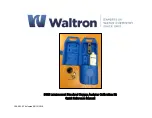
SYNRAD OEM v40 Operator’s Manual Version 4
32
Laser Safety
Serious
personal
injury
Do not allow laser radiation to enter the eye by viewing
direct or reflected laser energy.
CO2 laser radiation can be reflected from metallic objects
even though the surface is darkened. Direct or diffuse
laser radiation can inflict severe corneal injuries leading to
permanent eye damage or blindness. All personnel must
wear eye protection suitable for CO2 radiation, e.g. 9.3–10.6
µm when in the same area as an exposed laser beam.
Eye wear protects against scattered energy but is not
intended to protect against direct viewing of the beam—
never look directly into the laser output aperture or view
scattered laser reflections from metallic surfaces.
General hazards
Following are descriptions of general hazards and unsafe practices that could result in death,
severe injury, or product damage. Specific warnings and cautions not appearing in this sec-
tion are found throughout the manual.
Enclose the beam path whenever possible. Exposure to direct or diffuse CO
2
laser
radiation can seriously burn human or animal tissue, which may cause permanent
damage.
This product is not intended for use in explosive, or potentially explosive,
atmospheres!
Materials processing with a laser can generate air contaminants such as vapors,
fumes, and/or particles that may be noxious, toxic, or even fatal. Safety Data
Sheets (SDS) for materials being processed should be thoroughly evaluated and
the adequacy of provisions for fume extraction, filtering, and venting should be
carefully considered. Review the following references for further information on
exposure criteria:
ANSI Z136.1-2014, Safe Use of Lasers, §7.3.
U.S. Government’s Code of Federal Regulations: 29 CFR §1910, §§ Z.
Threshold Limit Values (TLV’s) published by the American Conference of
Governmental Industrial Hygienists (ACGIH).
It may be necessary to consult with local governmental agencies regarding
restrictions on the venting of processing vapors.
The use of aerosol dusters containing difluoroethane causes “blooming”, a condition
that significantly expands and scatters the laser beam. This beam expansion can
effect mode quality and/or cause laser energy to extend beyond the confines of
optical elements in the system, possibly damaging acrylic safety shielding. Do not
use air dusters containing difluoroethane in any area adjacent to CO2 laser systems
because difluoroethane persists for long time periods over wide areas.
Warning
Содержание Firestar V Series
Страница 29: ...getting started 29 SYNRAD OEM v40 Operator s Manual Version 4 This page intentionally left blank ...
Страница 85: ...technical reference 85 SYNRAD OEM v40 Operator s Manual Version 4 This page intentionally left blank ...
Страница 103: ...maintenance troubleshooting 103 SYNRAD OEM v40 Operator s Manual Version 4 This page intentionally left blank ...
















































